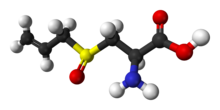
| |

| |
| Names | |
|---|---|
| Systematic IUPAC name
(2R)-2-Amino-3-[(S)-(prop-2-ene-1-sulfinyl)]propanoic acid | |
| Other names
3-(2-Propenylsulfinyl)alanine
(S)-3-(2-Propenylsulfinyl)-L-alanine 3-[(S)-Allylsulfinyl]-L-alanine S-Allyl-L-cysteine sulfoxide | |
| Identifiers | |
3D model (JSmol)
|
|
| ChEBI | |
| ChEMBL | |
| ChemSpider | |
| ECHA InfoCard | 100.008.291 |
| EC Number |
|
| KEGG | |
PubChem CID
|
|
| UNII | |
CompTox Dashboard (EPA)
|
|
| |
| |
| Properties | |
| C6H11NO3S | |
| Molar mass | 177.22 g·mol−1 |
| Appearance | White to off white crystalline powder |
| Melting point | 163–165 °C (325–329 °F) |
| Soluble | |
| Hazards | |
| GHS labelling: | |

| |
| Warning | |
| H315, H319, H335 | |
| P261, P264, P271, P280, P302+P352, P304+P340, P305+P351+P338, P312, P321, P332+P313, P337+P313, P362, P403+P233, P405, P501 | |
| NFPA 704 (fire diamond) | |
| Safety data sheet (SDS) | External MSDS |
Except where otherwise noted, data are given for materials in their standard state (at 25 °C [77 °F], 100 kPa).
| |
Alliin /ˈæli.ɪn/ is a sulfoxide that is a natural constituent of fresh garlic.[1] It is a derivative of the amino acid cysteine. When fresh garlic is chopped or crushed, the enzyme alliinase converts alliin into allicin, which is responsible for the aroma of fresh garlic. Allicin and other thiosulfinates in garlic are unstable and form a number of other compounds, such as diallyl sulfide (DAS), diallyl disulfide (DADS) and diallyl trisulfide (DAT), dithiins and ajoene.[2] Garlic powder is not a source of alliin, nor is fresh garlic upon maceration, since the enzymatic conversion to allicin takes place in the order of seconds.
Alliin was the first natural product found to have both carbon- and sulfur-centered stereochemistry.[3]
- ^ Iberl, B; Winkler, G; Müller, B; Knobloch, K (1990). "Quantitative Determination of Allicin and Alliin from Garlic by HPLC". Planta Med. 56 (3): 320–326. doi:10.1055/s-2006-960969. PMID 17221429. S2CID 30268881.
- ^ Amagase, Harunobu; Petesch, Brenda L.; Matsuura, Hiromichi; Kasuga, Shigeo; Itakura, Yoichi (2001). "Intake of Garlic and Its Bioactive Components". The Journal of Nutrition. 131 (3). Oxford University Press (OUP): 955S–962S. doi:10.1093/jn/131.3.955s. ISSN 0022-3166. PMID 11238796.
- ^ Block, E (2009). Garlic and Other Alliums: The lore and the science. Royal Society of Chemistry. pp. 100–106.
